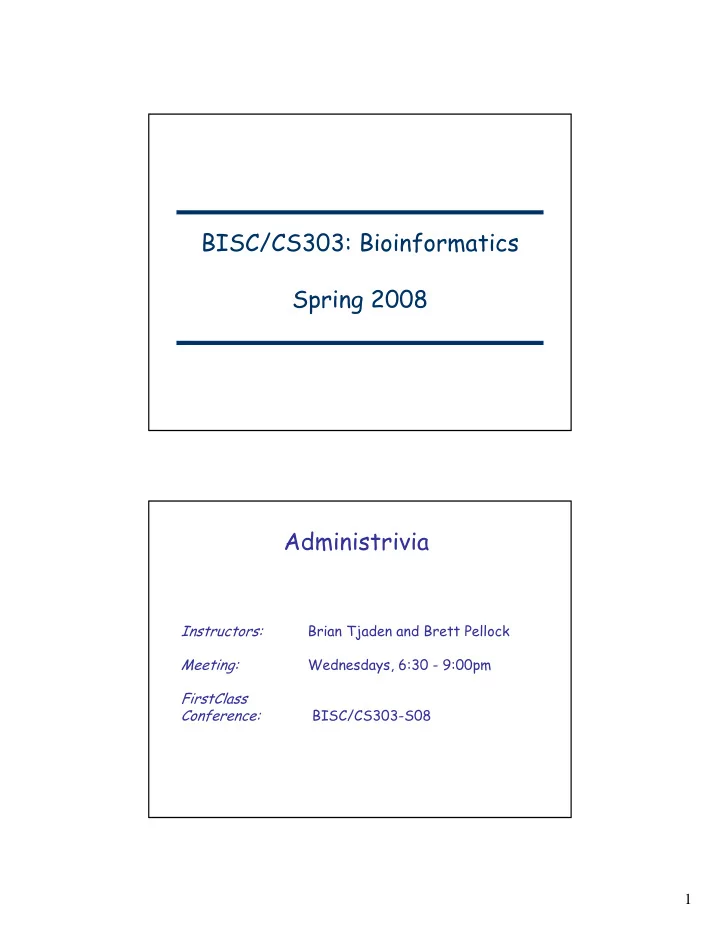

BISC/CS303: Bioinformatics Spring 2008 Administrivia Instructors: Brian Tjaden and Brett Pellock Meeting: Wednesdays, 6:30 - 9:00pm FirstClass Conference: BISC/CS303-S08 1
Course Materials http://cs.wellesley.edu/~cs303 Textbooks (optional, on reserve) Bioinformatics and Functional Genomics by Jonathan Pevzner John Wiley & Sons, Inc., 2003 Functional Concepts of Bioinformatics by D.E. Krane and M.L. Raymer Benjamin Cummings, 2003 2
BISC/CS 303 overview/grading: • Lecture • Computer Lab and Milestones • Final Project • Grading: • Milestones 60% • Project 30% • Presentation 10% Bioinformatics is multidisciplinary Computational Biological Bioinformatics tools data Focus is on how bioinformatic tools work 3
Today’s class: • Introduction to DNA • Information flow • The Genomics Era • Lab exercise 4
DNA: simplified DNA T C C AA C GG T G C T G A G G T G C AC Protein Gene DNA : “program” for cell processes Proteins : execute cell processes DNA Structure • “Double helix” • Deoxyribose (sugar) - phosphate backbone • Four bases – A, T, G, C • Base pairing 5
DNA Structure A T G C • Concepts: G C • Information polarity (anti-parallel strands) A T • Either strand can function as a template A T (complementary strands) G C Information Flow Nucleic acids Amino acids DNA RNA → Protein → transcription translation → → 6
DNA → RNA → Protein methionine polypeptide chain cysteine leucine glycine serine lysine of amino acids M L G C S K STOP translation GAACGCUAUGCUUGGGUGCUCUAAGUAAGCUAG mRNA transcription CGACTGAACGCTATGCTTGGGTGCTCTAAGTAAGCTAGTAAA GCTGACTTGCGATACGAACCCACGAGATTCATTCGATCATTT DNA gene The Genetic Code • 1 start codon (Met) • 61 amino acid codons • 3 stop codons 7
The Genetic Code • Triplet code • Non-overlapping codons • Start and stop codons • Degeneracy - 4 nucleotide bases, 20 amino acids -1 base = 4 codons (4 1 ) -2 bases = 16 codons (4 2 ) -3 bases = 64 codons (4 3 ) Commitment to information fidelity Amino acid tRNA anti-codon (adapter molecule) codons GAACGCUAUGCUUGGGUGCUCUAAGUAAGCUAG mRNA 8
Mutations • Changes in DNA occur, despite cell’s best efforts Normal RBCs • Spontaneous events, copying errors, enviromental factors • Mutations might change gene function • Can be harmful, neutral, or beneficial Sickle cell anemia Ultraviolet (UV) light causes sunburn and DNA damage 9
Types of Mutations Single base substitutions A T Insertions and Deletions Amplifications 9 CML Translocations 22 Inversions Sample Genomes A genome is the total DNA in a cell Species Genome size # of Genes Epstein-Barr virus 172 Thousand 80 Escherichia coli 4.6 Million 4,400 Drosophila melanogaster 122 Million ~14,000 Homo sapiens 3.3 Billion <25,000 Psilotum nudum (fern) 250 Billion ? 10
GenBank Growth (log scale) 100,000,000 Millions of DNA BasePairs Growth in DNA Sequencing 10,000,000 1,000,000 100,000 10,000 1,000 1982 1984 1986 1988 1990 1992 1994 1996 1998 2000 2002 2004 11
CPU Growth (log scale) Sequencing a Genome GTCAACAACTGAG CAGCTTTAGACCA GAGCTCA TTGCACG TTTAGAC ACTGAGCTCAAGGTTGCA ATGACAGCTTTAG CCGTCAACAA CAGCTTTAGACCA TGCACGTATGACA GTCAACAACTGAG TGCACGTATGACA ACTGAGCTCAAGGTTGCA ATGACAGCTTTAG CCGTCAACAA GAGCTCA TTGCACG TTTAGAC CCGTCAACAACTGAGCTCAAGGTTGCACGTATGACAGCTTTAGACCA 12
Comparative Genomics Comparative genomics involves understanding the relationships between the genomes of different species. - Which genes are present (conserved, unique)? - Infer function of genes by sequence similarity - homology to known genes - How are genes arranged in the genome? - Many genes have unknown functions 13
Open Questions... • Which regions of DNA have biologic function? (What are the genes?) • What are their functions? • When and how are genes turned on and off? • How do genes and their products (proteins) interact with each other? • What are the implications to health and medicine? in other words... How does the cell’s DNA “program” work? Recurring Themes - Bioinformatic tools are often hypotheses- generating - Identifying homologous regions between genomes can be very useful - Properties of data guide choice of algorithm - Determining statistical significance of results generated by bioinformatic tools 14
Recommend
More recommend